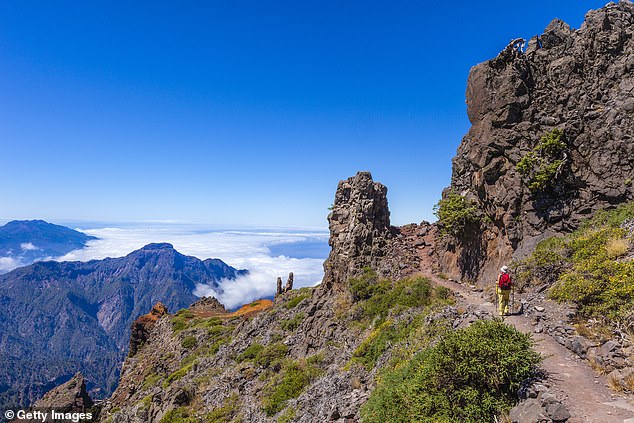Wind whips loose cinders off the huge hump of this naked grey mountain gashed by ruddy-tinged gullies. I gaze in disbelief, reminding myself of a preposterous fact: this whole mountain is yet to celebrate its third birthday.
For 86 days, ending in December of 2021, the Tajogaite (‘cracked mountain’) volcano came into thunderous being as it spewed ash and rivers of lava over the lush Aridane valley below. Homes, roads, fields and banana plantations were swallowed whole.
‘Sensational does not come close to what we witnessed,’ says Simon Orr-Ewing, a Canadian resident of La Palma licensed to guide groups into this otherwise out-of-bounds area of live volcanic activity. ‘But it was brutal, devastating. More than 7,000 people needed to be evacuated.’
To reach our vantage point, we had followed Simon along a trail through hardened ash lined with chunks of pumice. Treetops and chimneys poked through the blasted ground.
My wife Hennie and I are on a week-long La Palma’s Volcanic Trails itinerary, forged by walking specialist company Inntravel to take in the island’s astounding new-born landscapes. We stay in a trio of small hotels which we hike between with luggage transferred by taxi.

Rock star: Martin Symington and his wife travel to La Palma (pictured), where they join Inntravel’s Volcanic Trails itinerary, hiking between hotels to take in the Canary island’s scenery
Even before the eruptions temporarily closed the island to visitors, La Palma was a less-visited Canary. There are few beaches or hotels and negligible nightlife. Instead, it attracts niche markets such as walkers, nature-lovers and stargazers.
That La Palma is not particularly easy to reach is a plus. We get there via a propeller-plane hop from neighbouring Tenerife. It is lava at first sight – a hunk of serrated rock, draped with a ragged green shawl, adrift in the white-capped Atlantic. La Palma soars to a volcanic cone higher than Ben Nevis with Snowdon plonked on top.
Our first stay is in breezy little Santa Cruz, the main town, which in the days of the Spanish Empire was an important port. We find tree-shaded squares and pastel-painted houses with wooden balconies that could be in colonial Colombia.

Martin hikes to Tajogaite volcano (seen here), which erupted on the Spanish island in 2021. ‘It was brutal, devastating,’ says Simon Orr-Ewing, a Canadian resident of La Palma. ‘More than 7,000 people needed to be evacuated’

Above, a sign next to Tajogaite volcano directs hikers to various landmarks. ‘One thing about volcanic islands is the variety of terrain,’ says Martin
One thing about volcanic islands is the variety of terrain. Over the coming days we navigate dizzyingly deep valleys terraced into tiny plots of avocados and dragon trees, to emerge in brushland sprinkled with prickly pears. We plunge into lichen-hung laurel forest pocked with the cones of the eruptive past.
The latter hike leads us to Las Indias near the southern tip. On what is our most physically taxing day, we contour high above the craggy coastline then drop precipitously as the sea looms ever larger.
Beyond Las Indias we emerge on to vast flows of magma discharged from El Charco and San Juan volcanoes in 1712 and 1949 respectively. Our footsteps crackle and pop along a black cinder path. The bare lava makes me feel like an ant on the flank of an elephant. A side trail reveals inlets with waves crashing on bizarre black sculptures of solidified lava.

Along the way, Martin stays in Santa Cruz (pictured), La Palma’s main town. ‘We find tree-shaded squares and pastel-painted houses with wooden balconies that could be in colonial Colombia,’ he writes

Martin describes La Palma, pictured here, as a ‘hunk of serrated rock, draped with a ragged green shawl, adrift in the white-capped Atlantic’
The final stretch to our Llanos de Aridane town destination is by car on a new road bulldozed through the wasteland of the 2021 eruption. As our eyes follow thick, octopus tentacles of lava up towards Tajogaite, I am reminded that geography and geology are not history on an active volcano; they happen before your eyes.
I mentioned stargazing. With a clear atmosphere and light pollution minimised by law, La Palma is one of the best places on the planet for viewing the heavens. So, on our final evening, with astronomer Elena Nordio of Ad Astra, we corkscrew high up to Llano del Jable viewpoint.
Through Elena’s telescope, we are awed by Jupiter and its moons, by the Orion Nebula and the hazy Andromeda galaxy. Did I write earlier that La Palma has negligible nightlife? Sorry, scrub that. With swathes of lava below and diamonds in the sky, the nightlife is out of this world.
This article was originally published by a www.dailymail.co.uk . Read the Original article here. .


